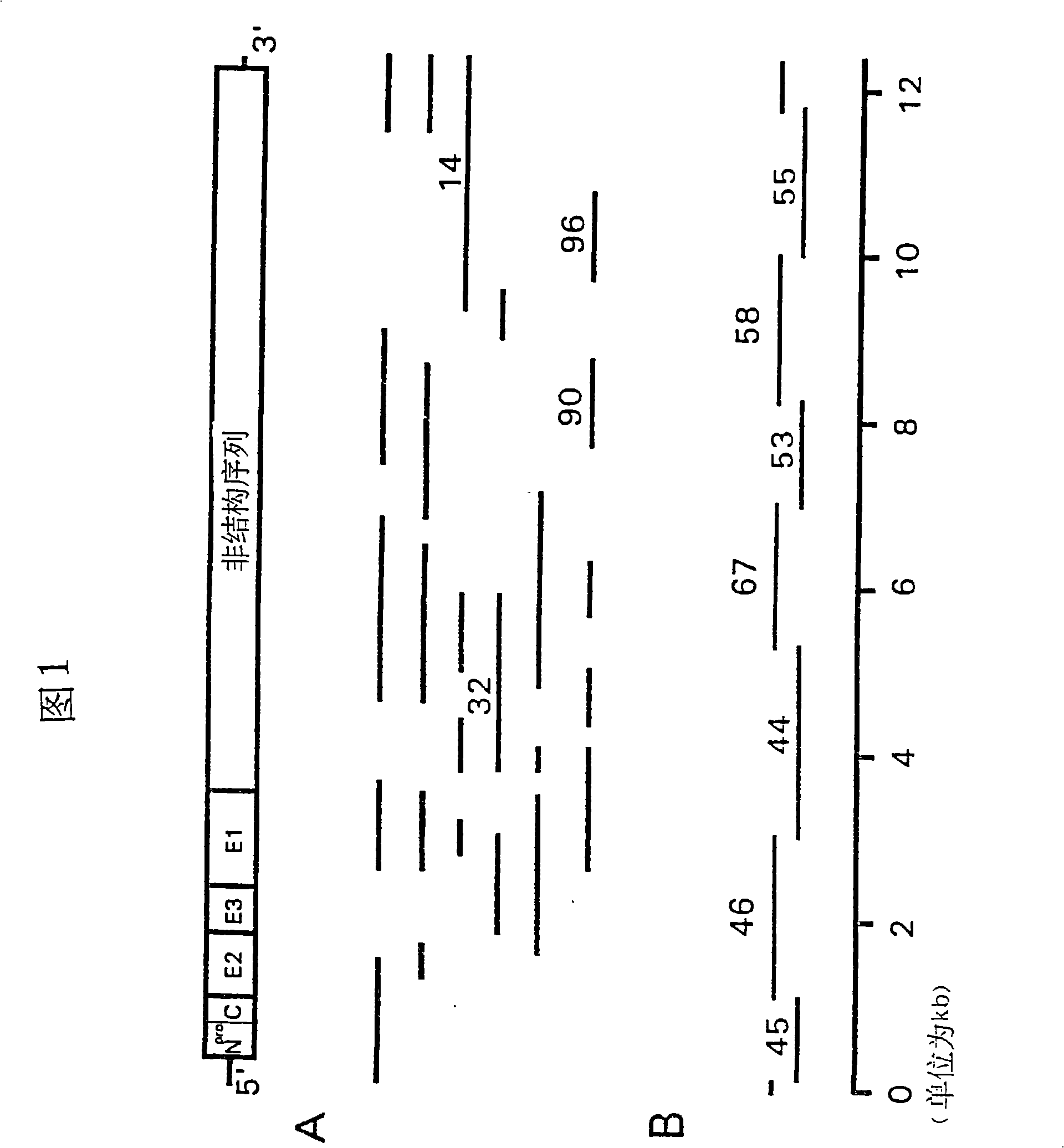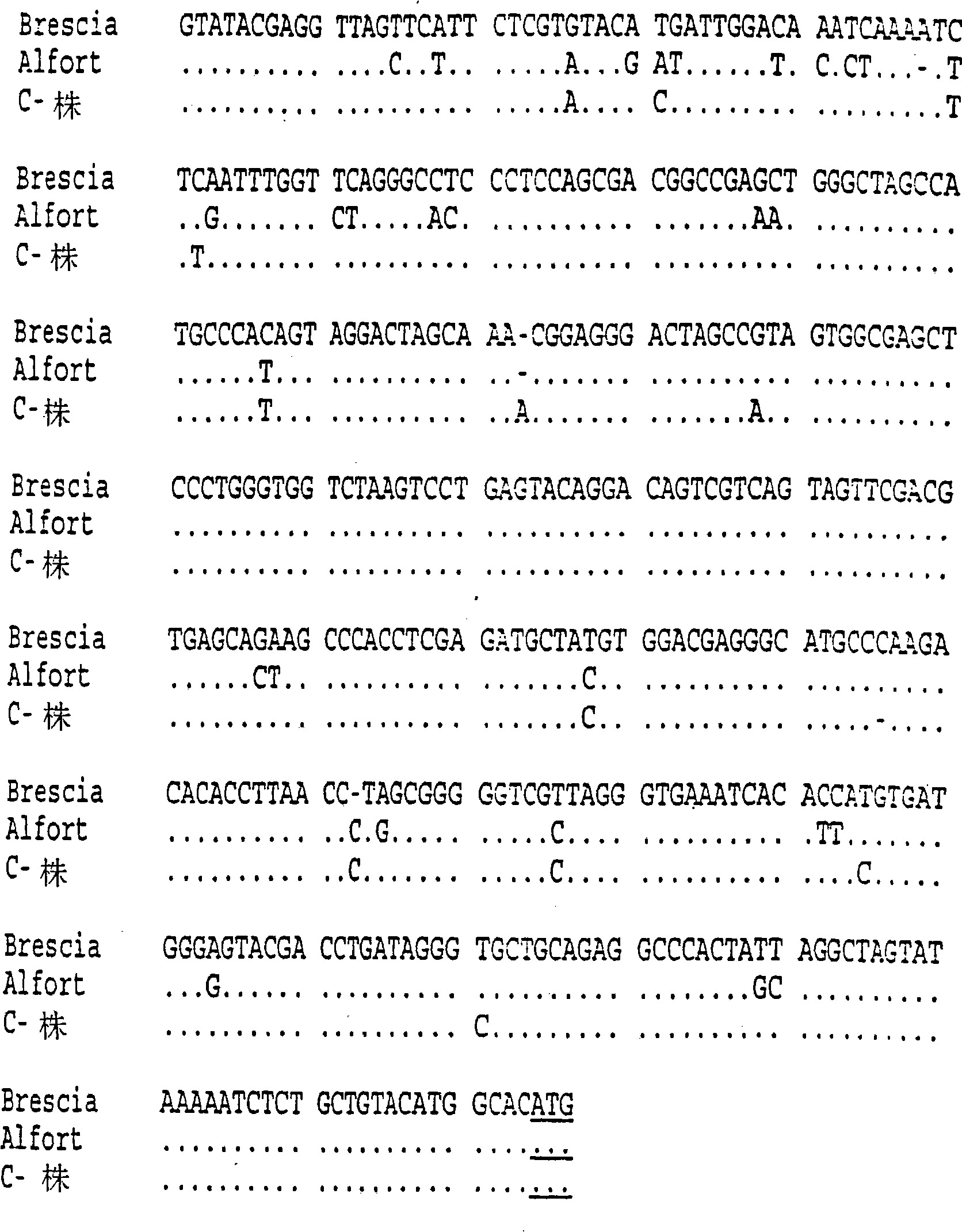Nucleotide sequences of pestivirus strains, polypeptides encoded by these sequences and use thereof for diagnosis and prevention of pestivirus infections
A nucleotide sequence, pestivirus technology, applied in the direction of viral peptides, applications, viruses, etc., can solve the problem of not being able to reliably predict the success of infectious RNA
- Summary
- Abstract
- Description
- Claims
- Application Information
AI Technical Summary
Problems solved by technology
Method used
Image
Examples
Embodiment 1
[0052] Molecular cloning and sequencing of embodiment 1C strain genome
[0053] cells and viruses
[0054] Pig kidney cells (SK6-M, EP-A-351901) were cultured on Eagle's minimal medium containing 5% fetal bovine serum (FBS) and antibiotics. FBS was tested for BVDV and antibodies to BVDV as described (Moormann et al. 1990, Virology 177:184-198). Only serum free of BVDV and BVDV antibodies can be used. The "Chinese" vaccine strain (strain C) of classical swine fever virus (CSFV) was adapted to SK6-M cells as described in EP-A-351901. The strain termed "Cedipest" was non-cytopathic and was biologically cloned by three-fold endpoint dilution. Three-step amplification produced titers of 3, 5, 10 6 TCID 50 / ml of the cloned virus stock.
[0055] Isolation of Cytoplasmic RNA from SK-6 Cells Infected with C Strain
[0056] Intracellular RNA from cells infected with strain C was neccessarily isolated as described (Moormann et al. 1990. Virolgy 177:198). Briefly, at 162cm 2 SK6...
Embodiment 2
[0068] The production of the infectious transcript of the full-length DNA copy of embodiment 2C strain genome
[0069] Construction of cDNA clone pPRKflc-113
[0070] according to the image 3 The patterns make up the full-length DNA copy of the C-strain genomic RNA. First, two subclones were constructed, one (pPRc64) containing the cDNA sequence of the 5' part of the genome (1-5,560 nucleotides), and the other (pPRc111) containing the cDNA sequence of the 3' part of the genome (5,463- 12,311 nucleotides). The initial construction of a full-length cDNA clone was attempted in pGEM4z-blue. However, this approach failed due to the instability of the full-length sequence inserted into this vector. To increase the stability of the clones, the 5' and 3' partially cloned inserts were recloned in derivatives of the low copy number vector pOK12 (Vieira and Messing, 1991, Gene 100:189-194), resulting in pPRc108 and pPRc108, respectively. pPRc123. To achieve this result, pOK12 was ...
Embodiment 3
[0093] Immunization of pigs with deletion mutants of E1
[0094] Construction and expression of deletion mutant of CSFV Brescia strain E1
[0095] It has been shown that TMR-deficient E1 of CSFV Brescia strain expressed in insect cells can induce a protective immune response against CSF in pigs (Hulst et al., 1993, J. Virol. 67: 5435-5442). Two distinct antigenic units, A and B+C, capable of inducing neutralizing antibodies against CSFV in the N-terminal half of El have also been identified (Wensvoort, 1989, General Virology. 70:2865-2876 ; Van Rijn et al. 1992. Vet Microbiol. 33: 221-230; Van Rijn et al. 1993. General Virology 74: 2053-2060). Furthermore, neutralizing antibodies against regions A and B+C showed synergy in neutralizing CSFV (Wensvoort 1989. General Virology 70:2865-2876). To evaluate the immunogenicity of E1 mutants with deletions in B+C regions or deletions in A regions, relevant constructs can be prepared on baculovirus vectors and the expressed mutant pro...
PUM
| Property | Measurement | Unit |
|---|---|---|
| concentration | aaaaa | aaaaa |
Abstract
Description
Claims
Application Information
 Login to View More
Login to View More - R&D Engineer
- R&D Manager
- IP Professional
- Industry Leading Data Capabilities
- Powerful AI technology
- Patent DNA Extraction
Browse by: Latest US Patents, China's latest patents, Technical Efficacy Thesaurus, Application Domain, Technology Topic, Popular Technical Reports.
© 2024 PatSnap. All rights reserved.Legal|Privacy policy|Modern Slavery Act Transparency Statement|Sitemap|About US| Contact US: help@patsnap.com










